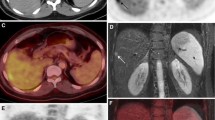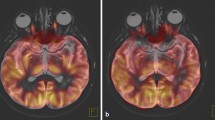Abstract
The introduction of hybrid positron emission/magnetic resonance tomography (PET/MR) in diagnostic clinical imaging was a major step in the evolution of ever-more sophisticated imaging systems combining two strategies formerly regarded as technically incompatible in a single device. The advent of PET/MR opened up many new avenues in clinical and research environments, mainly by providing multi-modality images obtained during a single examination. Ideally, simultaneous data acquisition with hybrid PET/MR should warrant exact image co-registration of all multi-modality image volumes provided by both systems. This assumes that there is negligible mutual electronic, technical and logistical interference on the respective simultaneous measurements. Recently, such hybrid dedicated head and whole-body systems were successfully applied in an increasing number of cases. When employed for brain imaging, PET/MR has the potential to provide high-resolution multi-modality datasets. However, it also demands careful consideration of the multitude of features offered, as well as the limitations. There are open issues that have to be considered, such as the handling of patient motion during extended periods of data acquisition, optimized sampling of derived images to ease the visual interpretation and quantitative evaluation of co-registered images. This paper will briefly summarize the current status of PET/MR within the framework of developments for image co-registration and discuss current limitations and future perspectives.






Similar content being viewed by others
References
Pelizzari CA, Chen GTY, Halpern H et al (1989) Accurate three-dimensional registration of CT, PET and/or MR images of the brain. J Comput Assist Tomogr 13:20–26
Pietrzyk U, Herholz K, Heiss WD (1990) Three-dimensional alignment of functional and morphological tomograms. J Comput Assist Tomogr 14:51–59
Skalski J, Wahl RL, Meyer CR (2002) Comparison of mutual information-based warping accuracy for fusing body CT and PET by 2 methods: CT mapped onto PET emission scan versus CT mapped onto PET transmission scan. J Nucl Med 43:1184–1187
Pietrzyk U (2001) Registration of MRI and PET images for clinical applications. In: Hajnal JV, Hill DLG, Hawkes DJ (eds) Medical image registration. CRC Press, Boca Raton, pp 199–216
Beyer T, Townsend DW, Brun T (2000) A combined PET/CT scanner for clinical oncology. J Nucl Med 41:1369–1379
Schlemmer HP, Pichler B, Schmand M et al (2008) Simultaneous MR/PET imaging of the human brain: feasibility study. Radiology 248:1028–1035
Delso G, Fürst S, Jakoby B et al (2011) Performance measurements of the Siemens mMR integrated whole-body PET/MRI scanner. J Nucl Med 52:1914–1922
Herzog H, Langen KJ, Weirich C et al (2011) High resolution BrainPET combined with simultaneous MRI. Nuklearmedizin 50:74–82
Drzezga A, Souvatzoglou M, Eiber M et al (2012) First clinical experience with integrated whole-body PET/MR: comparison to PET/CT in patients with oncologic diagnoses. J Nucl Med 53:845–855
Buchbender C, Heusner TA, Lauenstein TC et al (2012) Oncologic PET/MRI, part 1: tumors of the brain, head and neck, chest, abdomen, and pelvis. J Nucl Med 53:928–938
Zaidi H, Ojha N, Morich M et al (2011) Design and performance evaluation of a whole-body Ingenuity TF PET/MRI system. Phys Med Biol 56:3091–3106
Bergström M, Biethuis J, Eriksson L et al (1981) Head fixation device for reproducible position alignment in transmission CT and positron emission tomography. J Comput Assist Tomogr 5:136–141
Mazziotta JC, Phelps ME, Meadors AK et al (1982) Anatomical localization schemes for use in positron emission computed tomography using a specially designed headholder. J Comput Assist Tomogr 6:848–853
Fox PT, Perlmutter JS, Raichle ME (1985) A stereotactic method of anatomical localization for positron emission tomography. J Comput Assist Tomogr 9:141–153
Pietrzyk U, Herholz K, Fink G et al (1994) An interactive technique for three- dimensional image registration: validation for PET, SPECT, MRI and CT brain studies. J Nucl Med 35:2011–2018
Woods RP, Cherry SR, Mazziotta JC (1992) Rapid automated algorithm for aligning and reslicing PET images. J Comput Assist Tomogr 16:620–633
Woods RP, Mazziotta JC, Cherry SR (1993) MRI-PET registration with automated algorithm. J Comput Assist Tomogr 17:536–546
Wells WM III, Viola P, Atsumo H et al (1996) Multi-modal volume registration by maximization of mutual information. Med Imaging Anal 1:35–51
Maes F, Collignon A, Vandermeulen D et al (1997) Multi-modalityity image registration by maximization of mutual information. IEEE Trans Med Imaging 16:187–198
Studholme C, Hill DLJ, Hawkes D (1997) Automated three-dimensional registration of magnetic resonance and positron emission tomography brain images by multiresolution optimization of voxel similarity measures. Med Phys 24:25–35
Kuhl DE, Hale J, Eaton WL (1966) Transmission scanning: a useful adjunct to conventional emission scanning for accurately keying isotope deposition to radiographic anatomy. Radiology 87:278–284
Pietrzyk U, Scheidhauer K, Scharl A et al (1995) Presurgical visualization of primary breast carcinoma with PET emission and transmission imaging. J Nucl Med 36:1882–1884
Beyer T, Antoch G, Mueller SP et al (2004) Acquisition protocol considerations for combined PET/CT imaging. J Nucl Med 45:25S–35S
Beyer T, Freudenberg LS, Czernin J et al (2011) The future of hybrid imaging—part 3: pET/MR, small-animal imaging and beyond. Insights Imaging 2:235–246
Cho ZH, Son YD, Kim HK et al (2008) A fusion PET/MRI system with a high-resolution research tomograph-PET and ultra-high field 7.0T-MRI for the molecular-genetic imaging of the brain. Proteomics 8:1302–1323
Schmid D, Samarin A, Kuhn F et al (2011) Image registration accuracy of a sequential, trimodality PET/CT+MR imaging setup using dedicated patient transporter systems. http://m.rsna.org/rsna2011/program/event_display.cfm?em_id=11012910
Catana C, Benner T, van der Kouwe A et al (2011) MRI-assisted PET motion correction for neurologic studies in an integrated MR-PET Scanner. J Nucl Med 52:154–161
De Yong HWAM, van der Velden FHP, Kloet RW et al (2007) Performance evaluation of the ECAT HRRT: an LSO-LYSO double layer high resolution, high sensitivity scanner. Phys Med Biol 52:1505–1526
Heiss W-D (2009) The potential of PET/MR for brain imaging. Eur J Nucl Med Mol Imaging 36(Suppl1):S105–S112
Haacke EM (1999) Magnetic resonance imaging. Physical principles and sequences design. Wiley, London, pp 570–590
Van der Kouwe AJW, Benner T, Dale AM (2006) Real-time rigid body motion correction and shimming using cloverleaf navigators. Magn Reson Med 56:1019–1032
Friston KJ, Ashburner J, Frith CD et al (1995) Spatial registration and normalization of images. Hum Brain Map 2:165–189
Guerin B, Cho S, Chun SY et al (2011) Nonrigid PET motion compensation in the lower abdomen using simultaneous tagged-MRI and PET imaging. Med Phys 38:3025–3038
King AP, Buerger C, Tsoumpas C, Marsden PK, Schaeffter T (2012) Thoracic respiratory motion estimation from MRI using a statistical model and a 2-D image navigator. Med Image Anal 16:252–264
Müller-Gärtner HW, Links JM, Prince JL et al (1992) Measurement of radiotracer concentration in brain gray matter using positron emission tomography: MRI-based correction for partial volume effects. J Cereb Blood Flow Metab 12:571–583
Meltzer CC, Kinahan PE, Greer PJ et al (1999) Comparative evaluation of MR-based partial-volume correction schemes for PET. J Nucl Med 40:2053–2065
Rousset O, Rahmim A, Alavi A, Zaidi H (2007) Partial volume correction strategies in PET. PET Clin 2:235–249
Wang H, Fei B (2012) An MR image-guided, voxel-based partial volume correction method for PET images. Med Phys 39:179–195
Ullisch MG, Scheins JJ, Weirich C et al (2012) MR-based PET Motion correction procedure for simultaneous MR-PET neuroimaging of human brain. PLoSone 7(11):e48149
Neuner I, Kaffanke JB, Langen KJ et al (2012) Multi-modality imaging utilising simultaneous MR-PET for human brain tumour assessment. Eur Radiol. doi:10.1007/s00330-012-2543-x
Herzog H, van den Hoff J (2012) Combined PET/MR systems: an overview and comparison of currently available options. Q J Nucl Med Mol Imaging 56:247–267
Acknowledgments
We would like to thank all our colleagues at Forschungszentrum Jülich who contributed to results reported in this article and those obtained with the BrainPET/MRI installed at this centre. We are very grateful to Dr. D.R. Pillai for proofreading the manuscript.
Author information
Authors and Affiliations
Corresponding author
Rights and permissions
About this article
Cite this article
Pietrzyk, U., Herzog, H. Does PET/MR in human brain imaging provide optimal co-registration? A critical reflection. Magn Reson Mater Phy 26, 137–147 (2013). https://doi.org/10.1007/s10334-012-0359-y
Received:
Revised:
Accepted:
Published:
Issue Date:
DOI: https://doi.org/10.1007/s10334-012-0359-y




